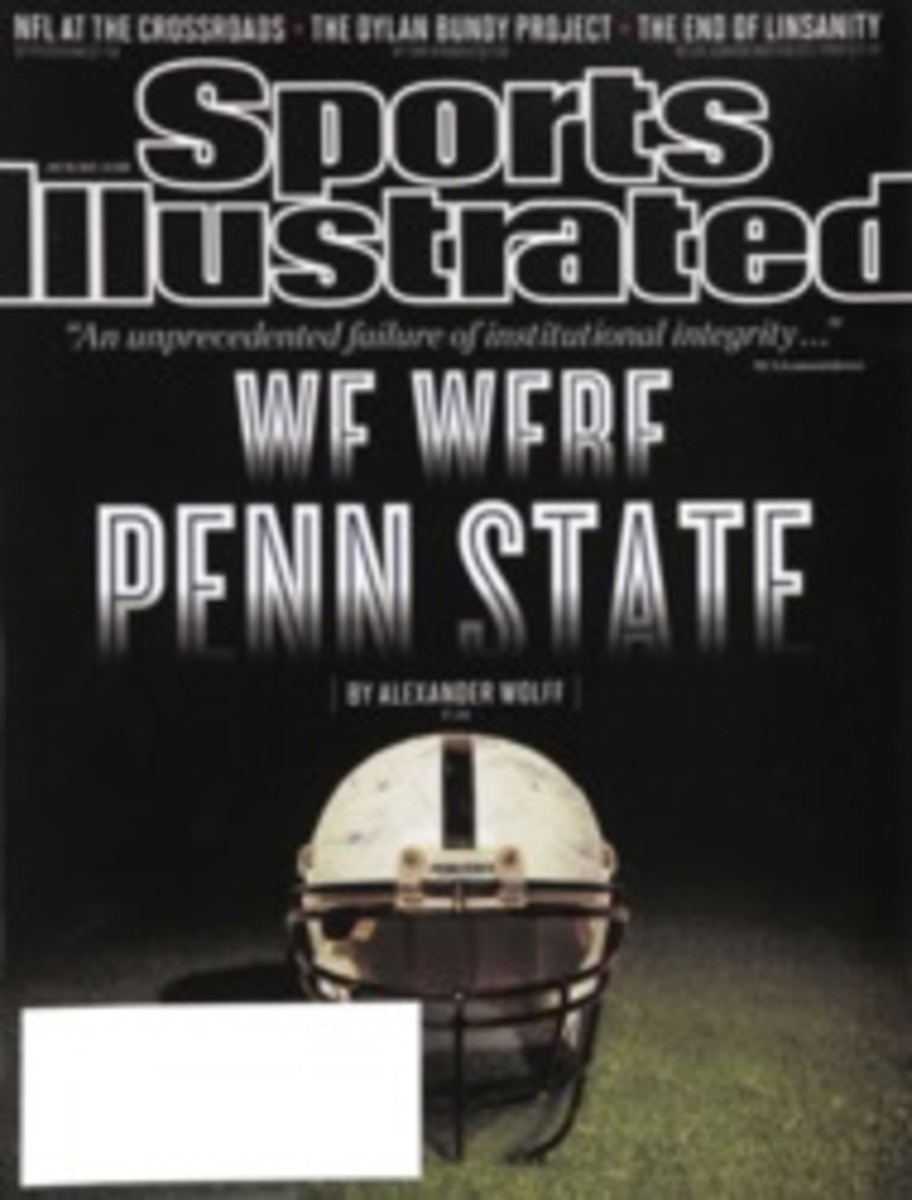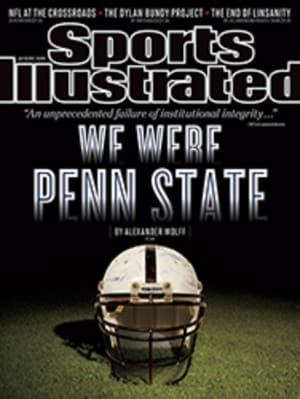
Is This the End for PENN STATE?
It's a heavy lift to get the public to accept that college sports pay more than lip service to ethics and justice. It's the kind of lift that might require a forklift—a forklift like the one that took the 900-pound bronze statue of former Penn State football coach Joe Paterno from the sidewalk outside Beaver Stadium on Sunday morning and moved it to the building's bowels. About an hour later word filtered into State College that the NCAA would deliver in fact what the removal of that statue had represented in symbol: an unprecedented repudiation of a storied college football program.
The next morning in Indianapolis, NCAA president Mark Emmert revealed the particulars of a consent decree reached with the university. The Nittany Lions are barred from postseason play for the next four years, and beginning in 2013 they will lose 10 scholarships annually through the 2016--17 academic year. (Current players will be able to transfer without having to sit out a season.) Penn State will vacate 111 of Paterno's once-record 409 victories, the ones he earned in the 14 years since the program first became aware of allegations that defensive coordinator Jerry Sandusky was molesting boys. And the school will set up a $60 million endowment to serve victims of child sexual abuse.
The Big Ten soon added its own punishment, saying it would withhold an estimated $13 million in revenue over four years, with the money also dedicated to helping victims of abuse. And there will be what Dan Monson, who took over Minnesota's men's basketball team just before it was put on probation in 2000 in the wake of an academic fraud scandal, calls the "unseen" sanctions: tougher admissions standards and less tolerance for the next dorm incident or DUI because academic officials have clawed back power. (To further ensure compliance, the NCAA also placed Penn State's athletic department on five years' probation.) The Nittany Lions didn't get the so-called death penalty, but theirs may turn out to be a fate worse than death—sanctions so debilitating that to force the team to continue to play under them is to leave it, to use the kind of imagery at the heart of the case, emasculated and humiliated. With its loyal fan base and location in the heart of a state that loves the game, the program has a chance of recovering. But it's going to take at least a decade, and in the meantime Penn State football will look a lot like Indiana football.
The NCAA's announcement came quickly for that famously deliberate organization, only 11 days after the release of a 267-page report by former FBI director Louis Freeh (which was commissioned and made public by the university) that could have used its own forklift for the damning weight it carried. Some three weeks before that, a jury had convicted Sandusky on 45 counts of sexually abusing 10 boys. "There clearly was and remains a sense of urgency in resolving this case," said Emmert, who knew the NCAA couldn't afford to let the Freeh Report and all its appalling detail linger unaddressed. From the school there would be no stonewalling or special pleading; the figures once in charge—president Graham Spanier, senior vice president Gary Schultz and athletic director Tim Curley—are all gone, with the last two awaiting trial, while Paterno died in January at age 84. The university's new regime wanted to take its lumps and move on.
Still, no number of docked scholarships, missed bowl trips or cash payments will counterbalance the enabling of a serial rapist of children. The NCAA has long since stopped assessing the death penalty, last used in Division I in 1987 against a recidivist SMU football program, because it believes the punishment causes too much collateral damage among blameless opponents who would suddenly lose television revenue. But with that $60 million fine, the NCAA went beyond its two typical types of sanctions, "corrective" and "punitive," to a kind of reparations or community service. It was an uncharacteristically creative penalty from an organization better suited to dealing with freebie tattoos and shopping sprees at Foot Locker than a run-amok culture.
The Penn State case presented a dilemma. If the scandal had emerged 10 or even five years ago, the NCAA would have probably left it entirely to civil authorities. But Emmert had to do something dramatic after a two-year stretch in which a succession of scandals—including inside the football programs at Ohio State (where players were trading memorabilia in exchange for tattoos) and USC (where the family of star running back Reggie Bush received improper benefits)—led to media criticism and left the organization's credibility in shambles. Last August, Emmert convened a summit of 54 university presidents to deal with the crisis. "There is an unwavering determination to change a number of things about intercollegiate athletics," one college president said then. "Presidents are fed up." That was Spanier, an Emmert wingman, with whom the NCAA president likely would have consulted over the past weeks if Spanier hadn't departed from Penn State in disgrace last November.
After the presidents' summit, Emmert tried to fast-track a package of limited reforms. But at January's convention he couldn't even get his membership to adopt one of its centerpieces, a modest $2,000 stipend to help athletes cover the cost of attending college. In the Penn State case the NCAA's executive committee and Division I board of directors, outraged over what Emmert called the "perverse and unconscionable" nature of the scandal, granted him authority to bypass the infractions committee, use the Freeh Report as a kind of proxy NCAA probe and act with unprecedented speed. Like a pro sports commissioner, he seemed to have asked for and received the power to act "for the good of the game."
For decades the NCAA invoked "a lack of institutional control" to punish programs when its understaffed and underpaid investigative teams couldn't come up with nitty-gritty evidence. And the Penn State case seemed to be the ultimate example of absent institutional controls. Only it wasn't really a lack of institutional control that allowed Sandusky free rein but a perverse surfeit of it held by the football program, made possible by what the Freeh Report calls "a culture of reverence"—a consuming desire to protect the team and Paterno, and their braided reputations, at an almost unimaginable human cost. The Freeh Report lays out a stark picture. Paterno, contrary to his testimony in January 2011 to the Sandusky grand jury, had been aware of a police investigation into allegations that his defensive coordinator had molested a child in 1998. In 2001, Curley, Spanier and Schultz seemed prepared to report another allegation—this one made not by a parent, as it was in the '98 case, but by then graduate assistant coach Mike McQueary—only to have Paterno apparently talk Curley out of it. In '04, on the heels of two straight losing seasons, Spanier and Curley went to Paterno's home to ask the coach to retire, only to slink meekly away after Paterno refused, making a mockery of the kind of reporting structure that marks a healthy institution. Meanwhile, Sandusky's molestations continued.
Once a monument to Paterno, the site of his statue had by Sunday evening become a shrine for a conflicted Penn State community. Into the grating of one nearby stadium gate someone had stuck a miniature JoePa figurine. Several undergraduates left a bouquet of yellow flowers with a note reading, "Joe, they may erase you from this site, but NEVER"—five times underlined—"from our hearts." Down at the base of the barrier, like a muffled cry, sat a copy of Feeling Safe, a book by a 10-year-old victim of sexual abuse.
By the players' entrance to the stadium a 69-year-old Penn State alumnus named Vin Tedesco stood alongside a life-sized cardboard cutout of Paterno. "For 60 years this guy lived, talked and required his soldiers to have truth and integrity," Tedesco said. "That's why it's hard for me to accept what's going on here. I may sound like a stupid old man, but the Freeh Report is being used by the university as a big deal. They paid a lot to get it."
As Tedesco spoke, the driver of a passing car shouted out his approval.
And then, moments later, a shout from another car: "F--- you!"
Penn Staters across the country are sorting themselves out alongside these poles of opinion. "I've written about sports scandals, and this is by far the worst in the history of college sports," says Charles Yesalis, a retired health policy, exercise and sports science professor at the school who now lives in Lynchburg, Va. "I'm astounded that there are going to be fans in those stands six weeks from now, or whenever the hell it is, cheering while a football team runs out on the field. That's an embarrassment.
"Look, I love football. I'm not one of those pinhead academics who hates sports.... [But] they shouldn't play football this year. And the NCAA shouldn't have to decide that. If Penn State really was what it's been telling people it's been about for all these years, they would stop the season. But they're not, and I'm embarrassed about that."
Also hung from that chain-link fence outside Beaver Stadium was a sign reading NO TRESPASSING. A familiar liturgy echoes in that last word. The forgiveness that the prayer calls for—for our own trespasses and those who trespass against us—is supposed to be a prerequisite to healing. But there's rancor even beyond the victims, among the Nittany Lions' faithful. Monday's sanctions assured Penn State of a long transit through the wilderness into which its football program has led it, and that will make healing still harder to come by.
Follow @alexander_wolff
The Nittany Lions didn't get the so-called death penalty, but theirs may turn out to be a fate worse than death.
PHOTO
Photograph by GENE J. PUSKAR/AP
PATERNO'S GHOSTS By Sunday evening all that remained of the monument to the iconic coach was a hole in the ground and the haunting images of four players.
PHOTO
JOHN BEALE/AP

